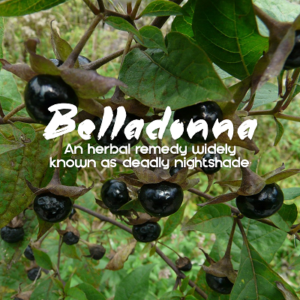 Belladonna is also called deadly nightshade, because it can kill you. The name “belladonna” came from beautiful women using the berries to enlarge their pupils and therefore be seen as more beautiful.
Belladonna is also called deadly nightshade, because it can kill you. The name “belladonna” came from beautiful women using the berries to enlarge their pupils and therefore be seen as more beautiful.
In ancient history, the plant itself was mainly used as a poison during war times, whereby the belladonna fruit was rubbed onto the arrow-heads, so they could poison their enemies.
However, it is also used as a homeopathic remedy to treat many different ailments and illnesses, and you can buy it over-the-counter in pharmacies.
Although there are medicinal qualities, extreme caution should always be observed when handling the plant, as belladonna is still considered a poisonous perennial herb, and should only be taken under the recommendation of your health care professional.
Belladonna Side Effects
Belladonna can show side effects in some patients, such as nausea, vomiting, shortness of breath, dizziness, seizures, difficulty in swallowing due to dryness in the mouth, and irregular heartbeat.
Being exposed to this plant in natural surroundings can also be dangerous as all parts of the plant are poisonous. Its toxic compounds can be absorbed directly through the skin, which means even handling the plant can be deadly.
Belladonna Relieves Some of the Following Health Problems:
Belladonna’s main active component, known as atropine, is effective in relieving:
- Gastrointestinal discomfort
- Normalizing digestive secretions
- Calming abdominal tremors
Therefore, it is often recommended for patients with:
- Gastric problems
- Digestive problems such as GERD (gastroesophageal reflux disease)
- Stomach ulcers and gastritis
Belladonna is also recommended for patients suffering from:
- Excessive sweating
- Motion sickness
- Nausea and muscle cramping
Medicinal Benefits of Belladonna
Belladonna can be diluted into a homeopathic formula for safe administering. Some of the medicinal benefits for belladonna include:
Relieving Menstrual Cramps
Belladonna is effective in relieving the cramps associated with menstrual pain.
Fevers and Infections
Belladonna is also recommended for treating ear infections. It can even help with the surrounding affected areas, such as the swelling of the glands.
It can be used in reducing fevers, and is also effective in treating the eye infection called conjunctivitis, if caught at an early stage. It also relieves the symptoms associated with light sensitivity, burning sensation, and swelling. It is administered in the form of a diluted eye-drop or as a topical agent.
Belladonna is used in many eye drops and is often used to dilate the pupils when an eye examination is conducted.
Yeast infections can also be treated with belladonna as a topical agent. It helps relieve the redness and itchiness associated with these types of infections.
Colic Pain in Infants
Professionals may also recommend belladonna to alleviate abdominal colic that causes discomfort and indigestion among infants. Belladonna is administered in a much-diluted form for this purpose, which makes it safe for ingestion.
Another benefit of belladonna is its ability to treat muscle spasms in patients with Parkinson’s disease. Although it hasn’t been proven that it can or could delay the progression of the disease, treating spasm of the muscles is a great relief for patients.
Belladonna has been extensively studied and experiments performed to produce a medication that is relatively safe for administration. It is usually sold in the form of a supplement, but is also available as an ointment, spray or liquid.
Taking belladonna without professional advice isn’t advised, and is of course warned against.






